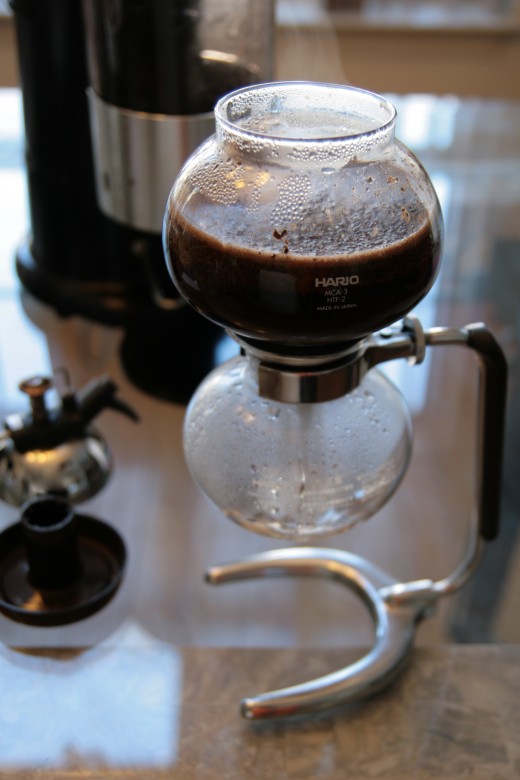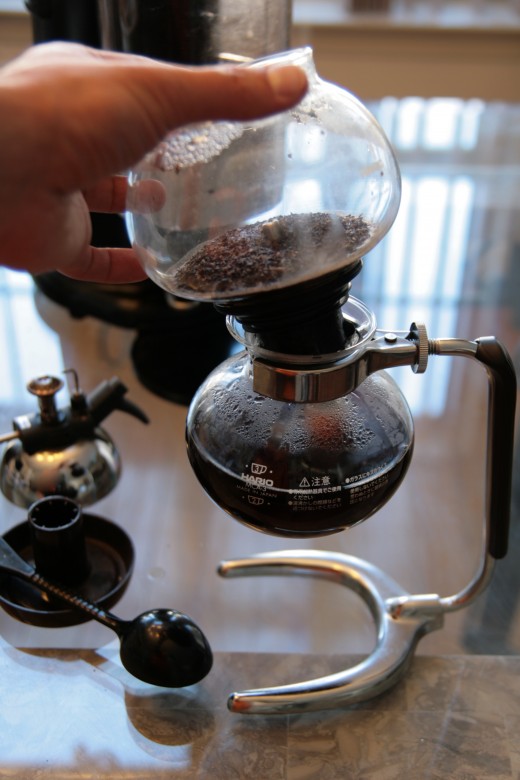Siphon Coffee Maker: Brewing the Best Cup of Coffee

Most have never heard of siphon brewing, or vacuum pot brewing, as it fell out of favor as a method for home brewed coffee during the 1960’s, but it remains as one of the best ways to create a wonderful cup of coffee. Its recent resurgence in coffee culture hasn’t been unwarranted to say the least. The cup it produces is clean, crisp and rich, as it fully extracts the many flavor nuances of various regional coffee beans. For those who take pride in producing the best result possible, it affords a very visual, and tactile brewing process. Not to mention, it’s just really cool. The entire siphon coffee apparatus borders on being a science project, and you get to be a “Mad Coffee Scientist”!
Vacuum Pot Brewers: How do they work?
Some will wonder about the “magic” behind a siphon brewer, but for those of you who don’t, feel free to skip down to the step by step segment. So, how does a siphon brewer work to produce a great cup? I’ll attempt to explain it here as simply as possible. There are basically four components to a siphon coffee maker. First, a lower glass (borosilicate) vessel, which holds the water to be heated initially and the brewed coffee after. The second piece is an upper glass vessel with the siphon tube extending from the bottom with a rubber gasket, which seals the upper and lower vessels and helps create the vacuum. The top vessel is where the grounds are placed and the “brewing” happens. Finally, there is the filter and heating element, which, I’ll get into the various types later. On to the process. First, water is placed into the bottom vessel, then the top vessel is placed carefully onto the bottom vessel, where the water is being heated. As some of the heated water is evaporated, it is converted into water vapor; this expanding gas(water vapor) forces the remaining heated water up into the top vessel via the siphon tube. Heat is maintained as the brewing progresses to keep the water up top, and within the ideal temperature range for brewing coffee of 190*F-205*F. Temperature is an important detail when it comes to good coffee, and a siphon brewer readily keeps you with the proper range. Once the coffee is steeped, or brewed for the preferred time, the heat is then removed to reverse the entire process. The vapor contracts in the bottom vessel and the resulting vacuum “pulls” the water back down into the bottom vessel and through the filter, so you are left with a clean, delicious cup of coffee.
Moving past the ad hoc science lesson.Here is the step by step guide to brewing with a siphon coffee maker. I want to add here that, there are certain keys to brewing a great cup of coffee as with any coffee brewing method. Those are to always use freshly roasted beans, to always grind your beans right before brewing and to maintain the proper brew temperature at all times during the brewing process. With regards to grinding, a good burr grinder that produces consistent coffee grounds is just as essential to good coffee as the way you choose to brew it. If you aren't already using one, you really want to step up from a blade grinder. This isn’t the end all be all way to brew with a vacuum pot either as steep times, stirring and when to add the coffee grounds can be adjusted to your own method or tastes. For me, I’ve found that this approach results in a consistently good cup.




















Siphon Coffee Maker Filters
The three predominate filter types for vacuum brewers are cloth, paper or a glass rod. A cloth filter is usually the de facto choice, as it is the type of filter that accompanies most modern day siphon coffee makers such as those from Yama. Many prefer this type of filter as it does an excellent job of filtering fine coffee grinds while still allowing the flavorful oils from the coffee through. Hario Glass, from Japan, produces a siphon paper filter, which is sold separately or included with some models. I find these easiest to clean and maintain, though, some debate that flavor is lost as some of the aforementioned volatile oils will be absorbed by the paper filter. Glass rods are also available if you can find them on eBay. Do a search for "Cory glass rod." A glass filter will give you the best of both a cloth and paper filter, but it doesn’t do the best job of filtering finer coffee grounds. It will allow coffee oils through and is very easy to clean, but some fine grounds will seep into the final product since the small nubs on the globe portion of the “filter” don’t do a fantastic job of actually filtering. Glass rods are also prone to clogging if you’re not careful. This is where the kick down phase of brewing is stalled due to too many fine grinds. You really need to be precise and have a good grinder to have consistent success with a glass rod filter.
Heating Elements
Every stand-alone siphon coffee maker is supplied with an alcohol wick burner, but they are slow to heat and not very capable. I'd recommend that you purchase a butane burner, as they provide a quick and effective heating source. You can find them on Amazon or woodworking tool websites. Butane refill canisters are also easily acquired at home improvement stores and other home retailers. Some siphon brewers are also made to be used on your stovetop. These are easily indicated by either their product description, or visually by looking for a flat-bottomed lower glass vessel.









